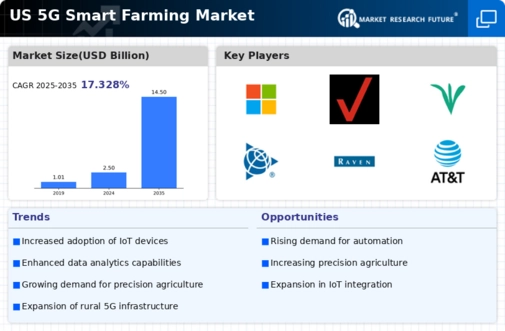Advancements in IoT Integration
The integration of Internet of Things (IoT) technologies into the 5g smart-farming market appears to be a pivotal driver. IoT devices facilitate real-time monitoring of soil conditions, crop health, and weather patterns, enhancing decision-making processes for farmers. With the deployment of 5G networks, the data transmission speeds are expected to increase significantly, allowing for more efficient data collection and analysis. This could lead to improved crop yields and reduced resource wastage. According to recent estimates, the IoT in agriculture market is projected to reach $20 billion by 2025, indicating a strong correlation with the growth of the 5g smart-farming market. The synergy between IoT and 5G is likely to create a more connected and responsive agricultural ecosystem.
Rising Demand for Food Security
The increasing global population and the corresponding demand for food security are driving the 5g smart-farming market. As the population is projected to reach 9.7 billion by 2050, the agricultural sector faces immense pressure to enhance productivity and sustainability. 5G technologies can facilitate precision agriculture, enabling farmers to optimize resource use and increase crop yields. This demand for efficient food production methods is likely to propel investments in smart farming technologies. Reports suggest that the smart agriculture market could grow at a CAGR of 24% from 2025 to 2030, indicating a robust growth potential for the 5g smart-farming market as it aligns with the need for food security.
Government Initiatives and Funding
Government initiatives aimed at promoting technological advancements in agriculture are likely to bolster the 5g smart-farming market. Various federal and state programs are designed to support farmers in adopting new technologies, including 5G connectivity. For instance, funding opportunities through the USDA and other agencies may provide financial assistance for farmers to implement smart farming solutions. This support could enhance the adoption rate of 5G technologies in agriculture, potentially leading to a more efficient and productive farming sector. As of 2025, it is estimated that government funding for agricultural technology could exceed $1 billion, which may significantly impact the growth trajectory of the 5g smart-farming market.
Technological Innovations in Agriculture
Technological innovations, particularly in automation and robotics, are emerging as key drivers for the 5g smart-farming market. The advent of autonomous tractors, drones, and robotic harvesters is transforming traditional farming practices. These technologies, when combined with 5G connectivity, can enhance operational efficiency and reduce labor costs. The ability to transmit large volumes of data in real-time allows for better coordination of these automated systems. As of 2025, the agricultural robotics market is expected to reach $6 billion, suggesting a strong interdependence with the growth of the 5g smart-farming market. This trend indicates a shift towards more technologically advanced farming practices.
Consumer Preferences for Sustainable Practices
Consumer preferences are increasingly shifting towards sustainable agricultural practices, which is likely to influence the 5g smart-farming market. As awareness of environmental issues grows, consumers are demanding transparency in food production processes. 5G technologies can enable farmers to implement sustainable practices by providing data-driven insights into resource management and environmental impact. This alignment with consumer values may encourage farmers to adopt smart farming solutions that utilize 5G connectivity. Market Research Future indicates that 70% of consumers are willing to pay a premium for sustainably produced food, which could drive the adoption of 5g technologies in agriculture as farmers seek to meet this demand.




















Leave a Comment